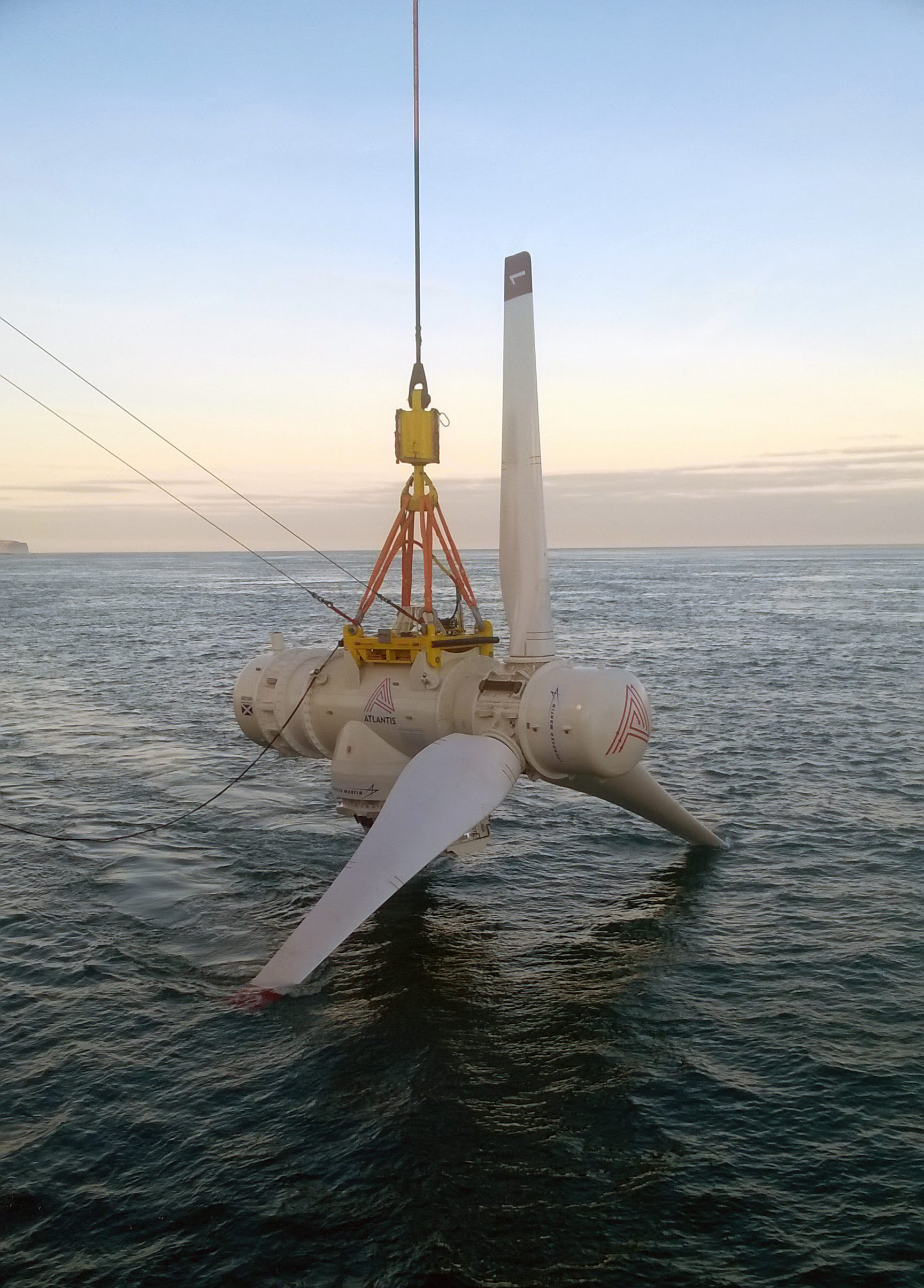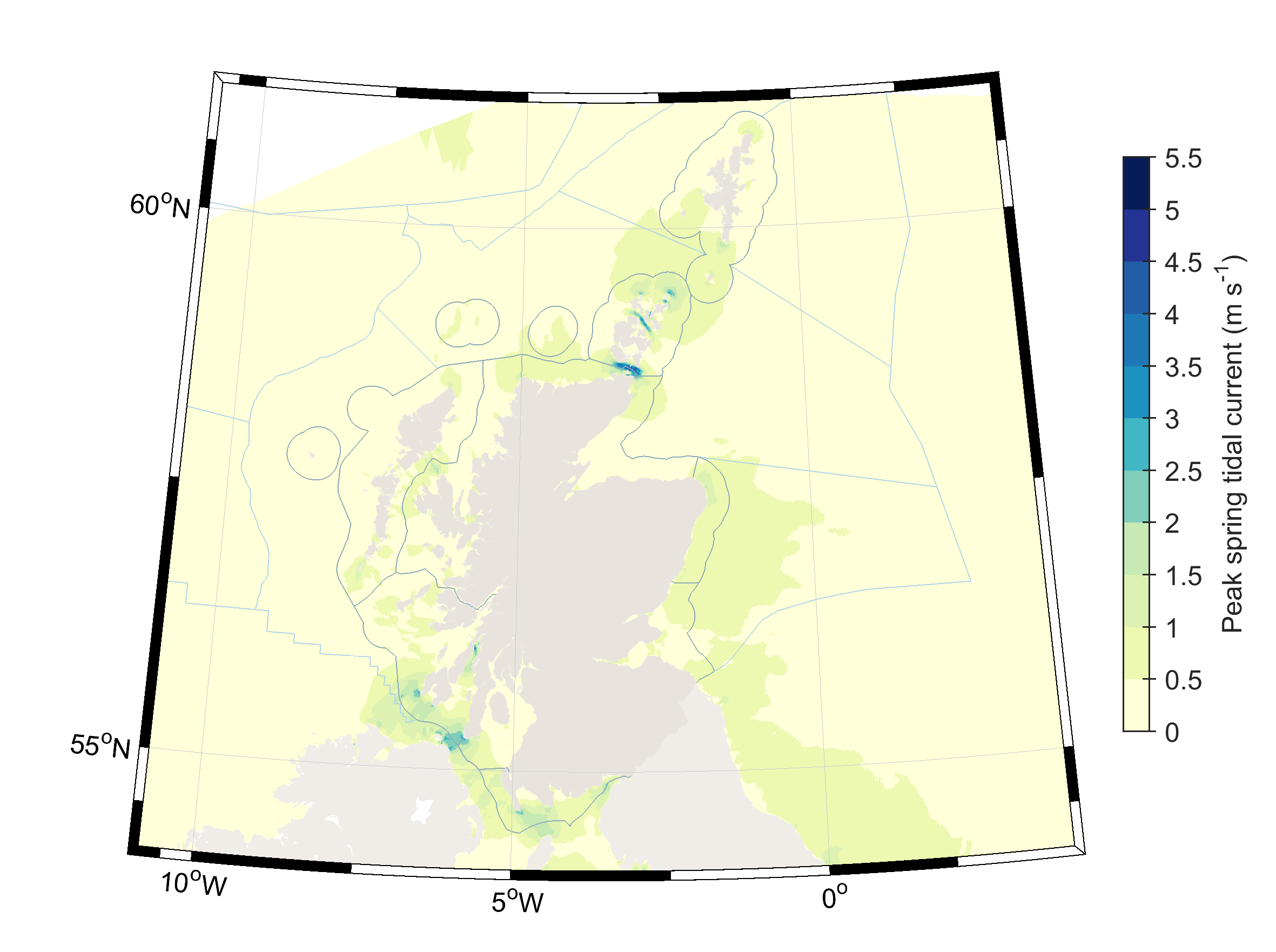Scotland is well placed to generate electricity from the tide as there are a number of regions that experience high tidal currents. Tidal energy can be harnessed in a number of ways, from building barrages across estuaries that experience a large tidal range to placing tidal stream turbines in areas of high current speeds. Tidal stream turbines are becoming the most common method of extracting energy from the tide: individual devices are likely to have a much lower overall environmental impact than tidal range developments such as barrages and lagoons, and developments can be built in phases enabling the environmental interactions to be studied.
ICES (2019) reported that whilst there is one example of a large tidal barrage in Europe (La Rance, France, built in 1966), there are large environmental concerns over the construction of future tidal range developments, such as lagoons. Most effort is being put into the licensing of tidal stream developments (ICES, 2019), and Scotland has adopted a “deploy and monitor” approach with the developments being built in phases.
It is estimated that Scotland’s marine area contains 25% of Europe’s tidal energy resource (Scottish Government, 2015) and it has been estimated to have around 32 TWh per year of potentially exploitable tidal stream resource (The Crown Estate, 2012). In 2018 Scotland’s combined gross electricity consumption was 24 TWh (Scottish Energy Statistics Hub). There is therefore the potential for Scotland’s tidal stream energy sector to significantly contribute to Scotland’s future energy requirements. This tidal stream resource is found in the narrow channels and off headlands of many of the western and northern Isles and the north coast of mainland Scotland, with the Orkney Islands and the Pentland Firth containing much of this resource.

Scotland has a semi-diurnal tide which leads to tidal sites experiencing high current speeds four times a day (during peak ebb and flood) with short periods of low current speeds in between. There is also a 14.8 day spring neap cycle due to the interaction of the earth, sun and moon. This means that tidal stream electricity generation would vary, with four peaks every day and two peaks every month. This resource is however, unlike wind power, predictable (see Sea level and tides).
Figure 2 shows the distribution of the fastest depth average current speeds experienced during spring tides across Scotland. Current speed is shown here as a proxy of the tidal power resource in Scottish waters. These data were obtained from a hydrodynamic model of Scottish seas – The Scottish Shelf Model. Figure 2 shows that the majority of the coastal seas around Scotland do not have tidal currents exceeding 1 m s-1, but there are small regions that regularly experience spring tide current speeds greater than 1 m s-1. However, most present day tidal stream turbines require speeds greater than 2.5 m s-1. Tidal power is proportional to the cube of the current speed, so significantly more power can be harnessed in these regions than in the slower 1 m s-1 regions. Figure 2 shows that there are limited locations where the tidal currents exceed 2.5 m s-1, mainly in the south-west (Argyll & Clyde regions) and the Orkney Islands and the Pentland Firth (Orkney Islands & North Coast regions). In these regions, there are a number of sites that experience fast tidal currents already leased to developers (see Renewable energy assessment). The majority of these sites are in the region known as the Pentland Firth and Orkney Waters (PFOW), which is also home to the European Marine Energy Test Centre (EMEC).
Figure 3 shows the typical spring tide velocities in the PFOW region, obtained from a high resolution hydrodynamic model of this region. In this region the fastest current speeds are found in the Pentland Firth, a channel separating the Orkney Islands from the north coast of mainland Scotland, where the current speed can exceed 5 m s-1. There are also a number of other Firths and Sounds where the currents are fast enough to make them viable sites for tidal stream energy extraction. See Neil et al. (2017) for a detailed overview of the Scottish tidal stream resource.

Figure 2: Annual mean depth average peak current speed at spring tide. Results were obtained from the Scottish Shelf Model.

Tidal stream developments can have impacts on the physical, biological and wider ecological environment. Tidal stream developments remove kinetic energy from the tidal stream and therefore lead to a reduction of tidal currents downstream of the development. There are also likely to be regions of flow acceleration around developments as the flow tends to bypass restrictions. For this reason there is usually an upper limit on the amount of energy that can be extracted from a tidal channel (Garrett & Cummins, 2005; Waldman et al., 2019).
Once this upper limit is met, any additional attempt to extract energy will only reduce the energy extracted and further increase the physical consequences such as flow reductions (Bryden & Couch, 2007). It is therefore important to consider what the balance between energy extraction and physical change is, and how to optimise energy removal whilst minimising the environmental impact. The problem is a complex one as a tidal turbine will interact with the flow and could change the available resource both for itself and other turbines in the region (Funke et al., 2014; Vennell et al., 2015; Waldman et al., 2019).
Small developments (such as those being constructed today) typically cause very little change to the tidal currents, but very large developments could lead to regional changes in the tidal stream. For example, O’Hara Murray & Gallego (2017) found that large tidal stream developments extracting 12.5 TWh per year from the Pentland Firth could lead to regional changes in the tidal range and current speeds. These potential changes to the underlying hydrodynamics could lead to further changes, both physical and ecological. For example, changes to current speeds could lead to changes in the transport of marine sediments. In practise, there is often very little sediment in regions of high current speeds, although there have been a number of studies investigating how tidal stream developments could change local and regional sediment transport (e.g. Neil et al., 2009; Fairly et al., 2015; Martin-Short et al., 2015).
Changes to the hydrodynamics could also lead to changes to vertical mixing and stratification in shelf seas, which could have some important ecological ramifications due to the biological importance of frontal regions (Sharples et al., 2006). There is also the potential for direct interactions between tidal stream developments and the biological component of the marine ecosystem, such as benthic organisms, fish, marine mammals and diving sea birds, and there have been a number of recent comprehensive reviews (e.g. Copping et al., 2016).
Marine ecosystems are adapted to their physical and chemical environment. Any changes in the physical characteristics of the marine environment can influence marine life and sustainable use of the seas. It is therefore important to understand changes in these physical and chemical characteristics in assessing whether we are working towards Scotland’s vision for clean, healthy, safe, productive, biologically diverse marine coastal environments, managed to meet the long-term needs of nature and people.
This assessment of physical and chemical characteristics covers, circulation, sea level, waves, temperature and salinity, as well as stratification and water clarity (turbidity).
The oceans are absorbing much of the carbon dioxide and excess heat resulting from a changing global climate. This absorption results in ocean acidification and increasing temperatures contribute to a loss of oxygen from the sea. These processes may have an adverse impact on marine life, and therefore the latest information on ocean acidification and dissolved oxygen (one of the Clean and safe Eutrophication assessments) are also presented.
The five case studies demonstrate some applications related to these assessments. These include a review of Scotland’s tidal stream resource, an example of dissolved oxygen measurements using novel technologies, and three illustrations of variability of ocean acidification and marine organisms (two species of calcifying plankton, coccolithophores and pelagic gastropods at Stonehaven, and one species of cold-water coral).
The Physical characteristics and ocean acidification assessment in Scotland’s Marine Atlas 2011 can be found on the Scottish Government web archive here.


